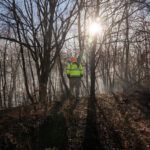A warming Arctic, another exhausted polar bear
By Dawn Stover | April 22, 2019
 Polar bears hunt for food, mostly seals, from sea ice. Credit: Peter Prokosch/www.grida.no/resources/1975
Polar bears hunt for food, mostly seals, from sea ice. Credit: Peter Prokosch/www.grida.no/resources/1975
When a polar bear showed up in the Russian village of Tilichiki on the Kamchatka Peninsula, surprised residents threw fish to the “exhausted” animal. Environmentalists say climate change likely forced the bear to look for food hundreds of miles from its normal habitat, but it’s possible the bear simply got stranded on a drifting ice floe. While not as gut-wrenching as the video of a dying bear that went viral in 2017, the video of the Russian bear shows an animal that “can barely move” by the time it swims to shore.
Polar bears normally live in Arctic regions with sea ice, which they use as a platform to hunt for seals. But this bear ended up hundreds of miles south of its home (and food source) in the Chukotka region bordering the Chukchi Sea. Authorities hope to return the lost bear to Chukotka by helicopter.
Surface air temperatures in the Arctic are rising twice as fast as the rest of the globe. For the past five years, they have broken all previous records since 1900. Arctic warming is not only melting the sea ice on which polar bears depend, but also shortening the season during which they can hunt for seals and accumulate the fat they need to make it through the ice-free summer.
Making matters even worse, National Geographic reports that seals and other animals eaten by bears are themselves dependent on a food chain that has at its foundation tiny organisms called zooplankton that feed on sea-ice algae. Like soil in a forest, the report says, sea ice appears to be essential to the Arctic ecosystem. Regardless of whether their numbers are increasing or decreasing, polar bears will not be able to survive in the wild if their habitat and food disappear.
According to the National Snow and Ice Data Center, Arctic sea ice likely reached its maximum extent for 2019 on March 13. This year tied with 2007 for the seventh-lowest maximum since the center began collecting satellite data 40 years ago. “While this is not a record low year for the Arctic sea ice maximum extent, the last four years have been the lowest in our record, reflecting a downward trend in winter sea ice extent,” said NSIDC senior research scientist Walt Meier. “This is just another indicator of the rapid changes that are occurring in the Arctic due to climate change.”
Publication Name: The Guardian
To read what we're reading, click here
Together, we make the world safer.
The Bulletin elevates expert voices above the noise. But as an independent nonprofit organization, our operations depend on the support of readers like you. Help us continue to deliver quality journalism that holds leaders accountable. Your support of our work at any level is important. In return, we promise our coverage will be understandable, influential, vigilant, solution-oriented, and fair-minded. Together we can make a difference.
Keywords: Arctic, polar bears, sea ice
Topics: Climate Change, What We’re Reading
















As long as I keep seeing stats on the polar ice decreasing in one study while another shows the opposite, I will continue to follow the money and biases it creates. As far as what we can do ourselves, instead of burning up carbon jetting off to endless summits on the power plays (and in the end that’s all these are), why not reduce each of our own footprints, invest in clean technology and plant some trees. Next would be to stop having more children than replaces us or even have less to reduce the burden on the planet. Having… Read more »
There are a lot of misunderstandings about “polar ice.” Are you referring to ice on land or to sea ice cover? The Arctic or Antarctica? The trend for sea ice cover in the Arctic is clear: “A satellite-based data record starting in late 1978 shows that indeed rapid changes have been occurring in the Arctic, where the ice coverage has been declining at a substantial rate.” https://neptune.gsfc.nasa.gov/csb/index.php?section=234
Have you been paying any attention to the work Peter Wadhams, Natalia Shakhova and Igor Semiletov have been doing with regards to rising Arctic temperatures and the effects that will have on methane release via permafrost thaw? It seems absolutely valid as an existential risk and I would strongly urge the Bulletin of Atomic Scientists to brief themselves and pay close attention to those developments.